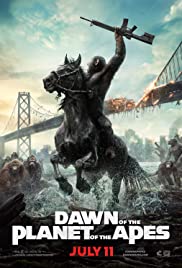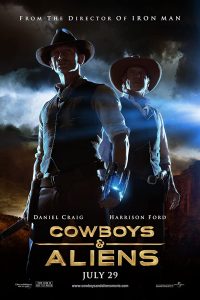‘Carrying That Weight’: A Review of Dawn of the Planet of the Apes
by Gary Westfahl
The original series of Planet of the Apes films took on the character of a cycle, as apes from the first two films traveled back in time to instigate the events that were seemingly leading, in the fifth film, to the emergence of the world of the first film. Dawn of the Planet of the Apes, properly characterized as the second film in the third series of Apes films, offers a cycle within a single film, as the filmmakers devote two hours of screen time to energetically taking their story back to its starting point. True, there are plenty of pyrotechnics to keep audiences entertained, but nothing is really done to advance the plot. That is, at the beginning of the film, humans and intelligent apes are poised to start fighting, they proceed to fight, and at the end of the film, their issues unresolved, they are poised to start fighting again, only with the promise of bigger and better battles in the next installment. As if director Matt Reeves wished to emphasize his film’s circular structure, its very first image, after an introductory montage, is an extreme close-up of the eyes of the apes’ leader Caesar (Andy Serkis), and its last image right before the credits is precisely the same. So, if you are interested in finding out the end result of the story that began in the previous film, Rise of the Planet of the Apes (review here), you can easily sleep in instead of confronting this Dawn, and you might skip the upcoming Morning, Afternoon, and Twilight of the Planet of the Apes as well, hoping that something meaningful might finally occur on the Night of the Planet of the Apes.
Instead of criticizing writers Mark Bomback, Rick Jaffa, and Amanda Silver, though, one should sympathize with them, as they were clearly instructed to construct a screenplay that would not only continue the saga of the previous film, but also lay the groundwork for an indefinite series of future films. (Reports indicate that Reeves and Bomback are already working on the next one.) To appreciate their achievement, one could reference James Blish’s old argument that there were two types of series in science fiction: “template series,” wherein each story is essentially the same, and “evolutionary series,” wherein a larger narrative unfolds and develops in each successive story. For film executives, template series are easier to execute and more likely to be profitable, as illustrated by the unending James Bond franchise: to come up with a new film, you simply create some horrid villain to threaten the world, you have Bond defeat him, and you take a break before crafting your next horrid villain. Evolutionary series, like the first five Apes films, are more complicated and less predictably popular, as devising ways to extend a larger story that should have ended long ago requires considerable ingenuity and may drive the franchise far away from its original character. In Dawn of the Planet of the Apes, Bomback, Jaffa, and Silver have efficiently transformed the Apes saga from an evolutionary series into a template series: it’s Apes Versus Humans, Round Two, and while the apes so far seem to be winning on points, you can’t count out those pesky humans, as like the Bond villains they seem likely to grow more crafty and resourceful in each upcoming round.
If there is something different about this film’s formula for success, it is that it lacks the moral clarity of traditional Hollywood melodramas, in which completely virtuous heroes face off against completely loathsome adversaries. Here, whereas the previous film conveyed that the apes were generally more admirable than the humans, the story emphasizes that both sides in this conflict have their heroes and villains. There are good humans, like Malcolm (Jason Clarke), his wife Ellie (Keri Russell), and son Alexander (Kodi Smit-McPhee), who want to get along with the apes, and there are bad humans, like Dreyfus (Gary Oldman), who want to kill them all because they unfairly blame them for the plague that devastated humanity. There are good apes, like Caesar, his wife Cornelia (Judy Greer), and son Blue Eyes (Nick Thurston), who wish to avoid a war with humans, and there are bad apes, like Koba (Toby Kebbell), who are happy to attack and kill the humans who once abused them. In case viewers miss the point, Caesar helpfully spells it out: “I always think ape better than human. I see now how much like them we are.” But since both apes and humans comprise a similar mixture of good and bad, the sympathies of the film’s audience are constantly shifting: whenever Caesar or Dreyfus dominates the scene, one roots for the apes against the humans, but when Koba or Malcolm comes to the forefront, one roots for the humans. Only in the end, after Caesar’s inevitable triumph over Koba, do the apes emerge as the film’s definitive heroes.
In one respect, however, the apes and humans remain significantly different, as the apes embody harmony with the natural world while humans represent artificial technology. Caesar’s cohorts are content to live in the forest and despise guns, destroying every one they find as they instead rely upon spears and bows and arrows to hunt and defend themselves. The humans have chosen to live in downtown San Francisco, are desperately seeking to sustain their electric power, and are eagerly planning to employ their huge stockpile of firearms against the apes. In most respects, the film clearly takes the apes’ side, as apes without guns are consistently able to defeat humans with guns, and one character remarks that because the apes “don’t need power,” “that makes them stronger.” Yes, the evil Koba at one point crosses the line and begins using guns to kill both human and ape opponents, but this ultimately leads to his downfall: for when Caesar seems about to kill Koba, the villain cleverly reminds the leader of one of the tribe’s cherished precepts: “ape not kill ape.” Yet after giving the matter a little thought, Caesar replies, “you are not ape,” and sends him falling to his death. If an ape picks up a gun, in other words, he is no longer truly an ape.
Yet there are clearly some advantages to advanced science, as when Cornelia gets very sick and Ellie cures her with antibiotics, and there are scenes where Alexander reads a book to the orangutan Maurice (Karin Konoval), and later gives him the book, indicating that at least some apes appreciate such material. Further, there is definite ambiguity in the scene after Malcolm finally gets a hydroelectric plant working, causing lights to turn on and a revolving sign to start revolving again. As the humans celebrate, audiences are also invited to celebrate this rebirth of technology. What I didn’t understand was why the Band’s classic song “The Weight” (1968) was chosen to be the first music played during this festive moment, since its enigmatic lyrics about a man’s visit to a small Southern town apparently bear little relationship to the film’s story. Perhaps it doesn’t mean anything – it was just one of the director’s favorite songs. Perhaps someone thought it would be nice to feature a song from the year – 1968 – when the Apes franchise was born. But just possibly, the writers were struck by the song’s theme of the “weight” that an individual must bear until it is passed on to somebody else. For certainly, anyone creating the eighth film in a series must feel that they are taking on the “weight” of carrying on a noteworthy tradition, responsible for replicating its best qualities, sustaining its success, and preparing for another installment. And Bomback, Jaffa, and Silver have visibly sought to relieve themselves of the burden of this franchise’s past by mostly ignoring it.
Thus, while Rise of the Planet of the Apes was filled with knowing references to earlier Apes films, there are few if any of them here. Only two things might be mentioned: the trite message that apes and humans should get along could be traced back to the fifth film, Battle for the Planet of the Apes (1973), and an anti-gun message briefly surfaced, in an almost joking matter, in Tim Burton’s Planet of the Apes (2001). More strikingly, the filmmakers have jettisoned the entire human cast of the previous film, although James Franco fleetingly appears in a video clip that Caesar watches when he revisits his old home. There may have been purely expedient reasons to not bring back certain performers, or this could represent a conscious strategy to foreground new characters in order to enliven an otherwise familiar story. Yet relying entirely on new humans, and making them uniformly one-dimensional, also conveys a message: that this is primarily a story about apes. Hence, the film does bring back several key apes to function as its true stars, though they are sometimes portrayed by different actors.
As I must confess, this focus on the apes may be one reason that I did not enjoy this film as much as its immediate predecessor, in which the humans were more prominent. One might speak of irrational prejudice, but a preference for looking at human faces is virtually hardwired into the human psyche, as experiments have demonstrated. Thus, audiences might find Roddy McDowall’s Caesar, who is visibly human despite his outlandish makeup, more appealing than Andy Serkis’s Caesar, who has been transformed by computers to look entirely like a genuine ape. As in the previous film, the apes also do not move like humans, as they effortlessly travel in three dimensions by skillfully using both their hands and their feet. Perhaps, despite Serkis’s excellent performance and a script that makes him thoroughly likable, we still might prefer to have someone who looks like James Franco as a viewpoint character.
As an additional problem, people may be unable to fully respect intelligent beings who do not resemble humans, especially ones who have long been regarded merely as animals. On one hand, the film makes fun of people who do not fully appreciate these apes’ abilities: in one scene, Koba confronts two men holding machine guns, and they could have easily shot him dead. But Koba cunningly begins acting like a circus animal, playfully cavorting and gibbering, so the men come to believe that he is entirely harmless. Later, however, he grabs a gun and kills them both. On the other hand, the screenwriters display precisely the same sort of inappropriate condescension in the dialogue that they write for Caesar and the other talking apes. We are informed repeatedly that Caesar is just as intelligent as a human being, and his vocal cords are capable of human speech. Yet he talks like a toddler, employing brief, simple sentences, one-syllable words, and ungrammatical constructions. How, then, can one admire Caesar’s vast intelligence when he says things like “ape not kill ape” and “I chose to trust him because he is ape”? One never questioned the acumen of the apes played by McDowall and Maurice Evans in the original Apes films precisely because they were very articulate, and if Serkis will indeed remain the leading actor in future films, he should be allowed to speak in his normal manner, showing off his English accent and properly conveying his human intellect. (I note, though, that the credits do identify one Michael Wilson as the film’s “ape vocal researcher,” presumably the Professor Michael Wilson of the University of Minnesota who has studied chimpanzee vocalizations, and it might be argued that Caesar’s speech accurately reflects the limitations of apes’ vocal cords. But if one can posit that apes can develop human intelligence, one can certainly imagine that their vocal cords might improve as well.)
If a sequel is inevitable, it would also be nice for it to have a setting other than San Francisco, which appears to be replacing New York City as the inevitable site of futuristic catastrophes; in fact, two of the last three films I have reviewed – Transcendence (review here) and Godzilla (review here) mostly took place in or near that California city. Thankfully, thirteen years after 9/11, filmmakers have finally realized that it is no longer clever or evocative to locate fictional disasters in New York City, and if New York represents the financial capital of the world, San Francisco, close to Silicon Valley, might be regarded as the technological capital of the world, and hence a fitting place for monsters and mutants to emerge. The difficulty filmmakers face is that they can never afford to actually film any scenes in San Francisco and instead, like the makers of this film and Godzilla, they more economically film their urban scenes in Vancouver, British Columbia. However, while it’s easy enough to put up “Market Street” and “California Street” signs in that Canadian metropolis, that uniformly flat city remains an unpersuasive substitute for the notoriously hilly San Francisco. Any viewer who has actually visited San Francisco, then, can immediately recognize that none of the actors in Dawn of the Planet of the Apes were actually in that city at any time.
One further worries that the next film, seeking to outdo its predecessor, will grow more and more violent, following the disturbing trend in this film. First, we only see the spears and arrows of the apes; then humans appear, bringing handguns and rifles. After the San Franciscans raid their armory, they and Koba come to rely entirely on machine guns; then, a human brings a tank into the fray, which is promptly commandeered by the apes. And at the end of the film, we are told that a human military force is advancing toward the city, probably equipped with grenades, rocket launchers, and drones to provide more excitement in upcoming battles. Surely, if the filmmakers are sincerely committed to offering the message that apes and humans should peacefully coexist, they should refrain from including scene after scene of apes and humans slaughtering each other. And one doesn’t need bullets and explosions to entertain audiences; if they want some genuine novelty in the next film, the writers might call a halt to the arms race and consider adding the one element from the original Apes film that the recent pair has entirely lacked: some gentle humor.
In looking over these comments, I recognize finally that contemporary Hollywood is entirely changing the way that people perceive films. Since virtually every major film, if successful, is certain to generate a sequel (and in many cases is already a sequel itself), audiences inevitably begin to view each film not as a complete narrative, but as one chapter in a larger story to be continued. And, instead of focusing entirely on the film itself, one begins speculating about its sequel: which threads in the plot will be picked up and continued, what characters will be doing to get themselves in the same predicament again, and what devices will be employed in the sequel to generate future sequels. In essence, every contemporary film now has an invisible companion – its forthcoming sequel – that inescapably becomes a part of its evaluation. So, consider this a review of both Dawn of the Planet of the Apes and the “Untitled Planet of the Apes Sequel” already scheduled to be released on July 29, 2016. And I must say that, based on the decline evidenced in the first two films, I am not looking forward to it.











I understand you had many problems with the film, as I will probably have when I finally see it. But your massive ruminating and parsing observances of the most trivial and eccentric make me believe there is not one iota of entertainment you can ever glean from movies you watch.